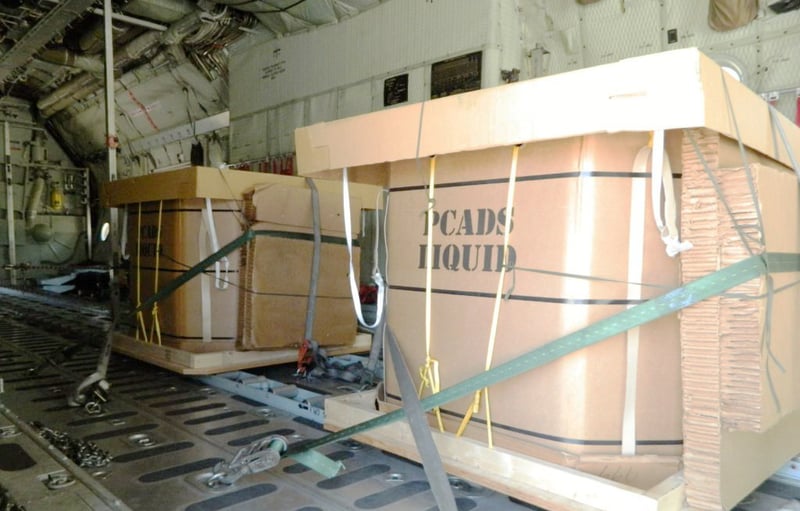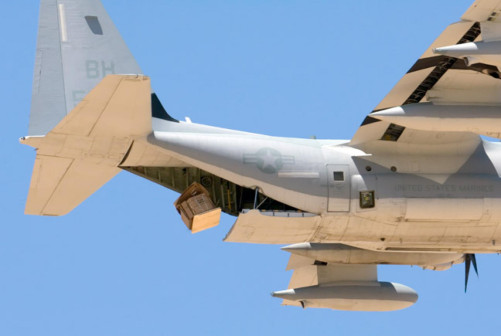As fire managers struggle to come up with new tactics and new technology to detect and fight wildfires, they are faced with dwindling budgets and more real estate development in areas which were once wilderness. Last year alone, 9,133 wildfires burned 1,381,405 acres in California, destroying 9,470 structures, damaging 810 more, killing 43 people, and running up a tab of over $13 billion in losses and suppression costs.
Many of the most destructive blazes occurred after the traditional summer wildfire season had ended, during a time of the year when seasonal firefighters leave the firefighting force to return to other occupations, shrinking the available firefighting force considerably. Many of the aircraft which fight wildfires were also entering their maintenance cycles and were unable to be called upon to fight the deadly October and December wildfires in Northern and Southern California.
1. Dwindling Numbers
2. A Dangerous Business
3. Precision Container Aerial Delivery System (PCADS)
4. No Modifications Necessary
5. Force Multiplier
6. Looking to the Future
Dwindling Numbers
Although aerial firefighters have never been as numerous as their brethren on the ground in the U.S., prior to 2002, as many as 48 heavy air-tankers were joined by swarms of helicopters and lighter aircraft as they grappled with wildfires nationwide. In recent years, however, their numbers have begun to dwindle.
After a pair of heavy air-tankers crashed in 2002, the U.S. Forest Service and the Department of the Interior grounded the entire fleet of 44 heavies due to airworthiness concerns raised by the National Transportation Safety Board, instructing their owners to have the wings inspected for telltale cracks that doomed the pair that crashed, effectively putting some operators, like Hawkins and Powers, out of business entirely. In the aftermath, only a handful of heavy air-tankers took to the skies again, supplemented by military C-130 aircraft equipped with MAFFS (Modular Aerial Fire Fighting System) units, which spray retardant out the back of the aircraft.
This year, the U.S. Forest Service only issued 13 exclusive-use contracts for heavy air-tankers, down from 20 contracts last season. The rest of the contracts they awarded were call-when-needed types, which don’t require the aircraft to be immediately available to fight wildfires. Many in the firefighting community protested this arrangement, but the Forest Service has refused to change their decision.
A Dangerous Business
Firefighters on the ground aren’t the only ones who face danger when fighting a wildfire. Aerial firefighters have their own list of hazards when fighting fires from the air, such as smoke obscuring visibility, terrain posing a navigational hazard, and civilian aircraft and drones flying into restricted zones where air-tankers are operating. Even highly-trained military crews sometimes fall victim to changeable weather over a wildfire, as happened to a military C-130 when a suspected microburst crashed their MAFFS aircraft in 2012, killing all but 2 of the crew.
Having already seen air-tankers grounded after crashes before, the aerial firefighting community continues to search for safer ways to fight wildfires. And in the meantime, many military aircraft which have not been modified to fight wildfires sit on the sidelines, unable to help as lives and property are lost to blazes that may be relatively close to the bases housing those aircraft.
So is there a solution to these problems? Enter PCADS.
Precision Container Aerial Delivery System (PCADS)
PCADS stands for Precision Container Aerial Delivery System, a new twist on the age-old firefighter axiom of ‘putting wet stuff on the hot stuff.’ “Basically, PCADS is an innovative aerial delivery firefighting system which uses a patented bottom skidboard/tray, sleeve and top cap design to secure a 1-ton bladder filled with water, firefighting gel, or any other firefighting chemicals,” said Ty Bonnar, President of Saint Industries, which developed and markets PCADS.
“PCADS was first realized back in 2004 when a kid threw a water balloon from a third story balcony, exploding water all over the ground,” he recalled. “One of the original members of the creation team, Boeing Aircraft’s William Cleary, envisioned multiple ‘water balloons’ being dropped from the C-17 Globemaster onto a wildfire. The team quickly realized that this tactic would not be effective in extinguishing the fire and knew they needed to find a way to burst the ‘water balloon’ above the fire and cause the water or fire retardant to rain down over the fire (direct attack) or in a line along the ground to form a containment line (indirect attack).”
The result was a unit which consists of a 48”x48” skidboard, with a bottom tray and sleeve system that contains a 250 US GAL bladder, and is secured to the skidboard via a patented intrinsic vertical restraint system. A top cap is then placed on top of the sleeve and is attached to the vertical restraint and the bladder rip cords. Once the bundle departs from the aircraft, the top cap separates from the sleeve, cuts the vertical restraint, and pulls the rip cords, rupturing the bladder, causing a rain effect. Each unit can be pre-set through a patented time delay system to open at a chosen altitude, so an aircraft can fly over a wildfire at a safe height, like 5,000’ AGL, when it performs a drop. The aircraft simply tips the nose up over the target and the PCADS units roll out the back, which is much safer and easier to do than having to dive-bomb a fire like most air-tankers do.
The PCADS unit can be dropped out the back of an existing, unmodified transport aircraft using the same methodology that the military has used for decades to deliver supplies and equipment to frontline troops. “Aircraft types which can use this unique firefighting system include the C-130 Hercules, L-100 (commercial C-130 variant), C-17 Globemaster, KC-390, C-27 Spartan, V-22 Osprey, and even helicopters like the CH-47 and CH-53,” he said. Many of these aircraft are available on military bases across the U.S. and around the world.

No Modifications Necessary
Another nice feature of PCADS is that costly modifications to aircraft don’t need to be made in order to use them. “The cost to modify an aircraft into an air-tanker is extremely expensive, and once these modifications have been completed, the aircraft is restricted to the aerial firefighting mission from that time forward,” said Bonnar. But with PCADS, no modifications are necessary. You simply load them onto a transport plane like you would any other cargo, tie them down, and take off.
Conventional air-tankers have to worry about visibility when flying over smoky wildfires during daytime hours, but with PCADS GPS coordinates suffice. No need to have a spotter aircraft fly ahead of the air-tanker to indicate when the air-tanker should drop. Just provide the GPS coordinates to the PCADS pilot and the load can be delivered on target from a safe altitude.
One other feature of PCADS which fire managers favor is attacking a wildfire from the air at night. What has previously been far too dangerous for fixed-wing air-tankers, night attack on wildfires is simplicity itself with PCADS. As with daytime operations, the transports need only know the GPS coordinates of the target and fly into the fire zone at a safe altitude, drop their PCADS load when they reach the coordinates, then fly home to reload for another mission.
Force Multiplier
Military transports could now swell the numbers of aircraft available for the wildland firefighting mission. All of those transport aircraft which have been forced to sit on the sidelines while a handful of MAFFS-equipped C-130s join a few military helicopters and tilt-rotors with Bambi buckets fight wildfires, could finally join the battle.
But how long would it take to load a transport with PCADS units? “It would take 15-20 minutes to actually load PCADS into a C-130 transport,” Bonnar said. “Once an airbase receives a call to dispatch a C-130 to a fire it would take 30-60 minutes to get the plane loaded and airborne,” he added.
Considering the number of transport planes on military bases in Southern California, this could be a tremendous force-multiplier for fire managers. “The PCADS basic CDS [Container Delivery System] design also allows it to be deployed from any civilian airframe having standard cargo-carrying rails and rollers with an aft ramp,” Bonnar pointed out. Which means that even civilian aircraft could be pressed into the fight in a pinch.
And if more need to be prepared, Saint Industries has developed a method whereby PCADS can be assembled in a jiffy. “It takes two people just 8 minutes to put one together,” he explained. “We typically set up a production line. A crew of 6 can build approximately 80 units in an 8-hour day.”
Looking To The Future
The military likes what it sees, as Bonnar pointed out. “In the 2015 US Air National Guard (ANG) Domestic Capability Priorities document, a CDS Aerial Firefighting System was published on the Critical Capabilities List, and started the road forward for the 2017 Operational Utility Evaluation (OUE) of PCADS as a solution to this critical capability requirement.” PCADS passed the OUE conducted by the ANG Test Agency and the final report was published earlier this year.
Multiple state ANG Units are working with Saint Industries to add CAFFS to their other current methods of airdrop, so what started as a Southern California phenomenon is expanding out to other states, and beyond. “PCADS has also been adopted as the Royal Thai Air Force’s Aerial Firefighting System, with several other countries preparing to adopt PCADS as well,” Bonnar said proudly.
